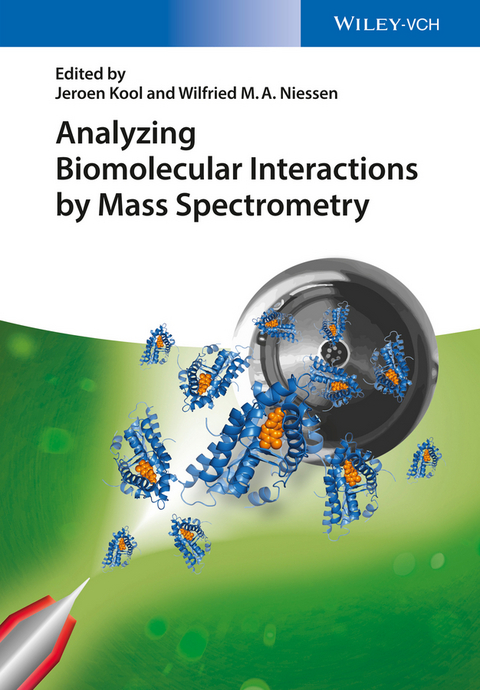Analyzing Biomolecular Interactions by Mass Spectrometry
Wiley-VCH (Verlag)
978-3-527-33464-3 (ISBN)
Jeroen Kool focused on the integration of chemical and biochemical detection after separation methodologies during his PhD study at the VU University Amsterdam. Following his PhD, he was responsible for target evaluation, hit screening and identification, and lead optimization processes at Kiadis Pharma. He continued his academic career in 2005 as a postdoc in the Biomolecular Mass Spectrometry group in Utrecht working on proteomics and biomarker discovery. From 2007 to present, he is responsible for the research line Bioanalytical Screening Methodologies at the VU University Amsterdam with a particular focus on hyphenated analytical techniques combining mass spectrometry and chromatography with novel bioassay techniques for bioactive mixture analysis. He published over 50 peer reviewed articles and one book chapter. Wilfried M.A. Niessen studied chemistry at the VU University Amsterdam. After his PhD, he worked for 9 years as an analytical chemist within the Leiden/ Amsterdam Center for Drug Research at Leiden University. After leaving the university in 1996, he started the company hyphen MassSpec, providing independent consultancy and training in the field of analytical mass spectrometry. In parallel to this, he was extraordinary professor in bioanalytical mass spectrometry at the Faculty of Science of the VU University Amsterdam between 2002 and 2014. There, he was involved in high-resolution screening and the role of MS therein. His main research interests involve principles, instrumentation and applications of liquid chromatography-mass spectrometry as well as interpretation of small-molecule MS-MS mass spectra. He is (co)author of more than 200 peer reviewed publications in the field of LC-MS and more than 40 book chapters. Wilfried Niessen authored and edited five books, and was guest editor on several special journal issues.
Preface
INTRODUCTION TO MASS SPECTROMETRY, A TUTORIAL
Introduction
Figures of Merit
Analyte Ionization
Mass Analyzer Building Blocks
Tandem Mass Spectrometry
Data Interpretation and Analytical Strategies
Conclusion and Perspectives
PART I: Direct MS Based Affinity Techniques
STUDYING PROTEIN-PROTEIN INTERACTIONS BY COMBINING NATIVE MASS SPECTROMETRY AND CHEMICAL CROSS-LINKING
Introduction
Protein Analysis by Mass Spectrometry
Native MS
Chemical Cross-Linking MS
Value of Combining Native MS with Chemical Cross-Linking MS
Regulating the Giant
Capturing Transient Interactions
An Integrative Approach for Obtaining Low-Resolution Structures of Native Protein Complexes
Future Directions
NATIVE MASS SPECTROMETRY APPROACHES USING ION MOBILITY-MASS SPECTROMETRY
Introduction
Sample Preparation
Electrospray Ionization
Mass Analyzers and Tandem MS Approaches
Ion Mobility
Data Processing
Challenges and Future Perspectives
PART II: LC-MS Based with Indirect Assays
METHODOLOGIES FOR EFFECT-DIRECTED ANALYSIS: ENVIRONMENTAL APPLICATIONS, FOOD ANALYSIS, AND DRUG DISCOVERY
Introduction
Principle of Traditional Effect-Directed Analysis
Sample Preparation
Fractionation for Bioassay Testing
Miscellaneous Approaches
Identification of Confirmation Process
Conclusion and Perspectives
MS BINDING ASSAYS
Introduction
MS Binding Assays - Strategy
Application of MS Binding Assays
Summary and Perspectives
METABOLIC PROFILING APPROACHES FOR THE IDENTIFICATION OF BIOACTIVE METABOLITES IN PLANTS
Introduction to Plant Metabolic Profiling
Sample Collection and Processing
Hyphenated Techniques
Mass Spectrometry
Mass Spectrometric Imaging
Data Analysis
Future Perspectives
ANTIVENOMICS: A PROTEOMICS TOOL FOR STUDYING THE IMMUNOREACTIVITY OF ANTIVENOMS
Introduction
Challenge of Fighting Human Envenoming by Snakebites
Toolbox for Studying the Immunological Profile of Antivenoms
First-Generation Antivenomics
Snake Venomics
Second-Generation Antivenomics
Concluding Remarks
PART III: Direct Pre- and On-Column Coupled Techniques
FRONTAL AND ZONAL AFFINITY CHROMATOGRAPHY COUPLED TO MASS SPECTROMETRY
Introduction
Frontal Affinity Chromatography
Staircase Method
Simultaneous Frontal Analysis of a Complex Mixture
Multiprotein Stationary Phase
Zonal Chromatography
Nonlinear Chromatography
ONLINE AFFINITY ASSESSMENT AND IMMUNOAFFINITY SAMPLE PRETREATMENT IN CAPILLARY ELECTROPHORESIS-MASS SPECTROMETRY
Introduction
Capillary Electrophoresis
Affinity Capillary Electrophoresis
Immunoaffinity Capillary Electrophoresis
Capillary Electrophoresis-Mass Spectrometry
Application of ACE-MS
Applications of IA-CE-MS
Conclusions
LABEL-FREE BIOSENSOR AFFINITY ANALYSIS COUPLED TO MASS SPECTROMETRY
Introduction to MS-Coupled Biosensor Platforms
Strategies for Coupling Label-Free Analysis with Mass Spectrometry
New Sensor and MS Platforms, Opportunities for Integration
PART IV: Direct Post Column Coupled Affinity Techniques
HIGH-RESOLUTION SCREENING: POST-COLUMN CONTINUOUS-FLOW BIOASSAYS
Introduction
The High-Resolution Screening Platform
Data Analysis
Conclusions and Perspectives
CONCLUSIONS
Index
| Erscheint lt. Verlag | 18.3.2015 |
|---|---|
| Verlagsort | Berlin |
| Sprache | englisch |
| Maße | 170 x 244 mm |
| Gewicht | 1010 g |
| Themenwelt | Medizin / Pharmazie ► Pharmazie |
| Naturwissenschaften ► Chemie ► Analytische Chemie | |
| Naturwissenschaften ► Physik / Astronomie ► Atom- / Kern- / Molekularphysik | |
| Schlagworte | Analytische Chemie • Biopolymere • biopolymers • Biowissenschaften • Chemie • Chemistry • Genomforschung u. Proteomik • Genomics & Proteomics • Genomics & Proteomics • Life Sciences • Massenspektrometrie • Mass Spectrometry • Pharmaceutical & Medicinal Chemistry • Pharmaceutical & Medicinal Chemistry • Pharmazeutische u. Medizinische Chemie • Polymer Science & Technology • Polymer Science & Technology • Polymerwissenschaft u. -technologie |
| ISBN-10 | 3-527-33464-5 / 3527334645 |
| ISBN-13 | 978-3-527-33464-3 / 9783527334643 |
| Zustand | Neuware |
| Informationen gemäß Produktsicherheitsverordnung (GPSR) | |
| Haben Sie eine Frage zum Produkt? |
aus dem Bereich




